#Department of Environment and Natural Resources (DENR)
Explore tagged Tumblr posts
Text
San Miguel Corporation’s “Better Rivers PH” initiative removes 93,000 tons of silt and waste from Parañaque rivers
Parañaque City benefited from the “Better Rivers PH” initiative of San Miguel Corporation (SMC) as ninety-three thousand tons of silt and waste was removed from the rivers of the city and other improvements were also done, according to a Business Mirror news report. To put things in perspective, posted below is an excerpt from the Business Mirror news report. Some parts in boldface… San…
#Asia#Bagong Parañaque#Better Rivers PH#Bing#Blog#blogger#blogging#capitalism#capitalist#Carlo Carrasco#ChatGPT#City Government of Parañaque#City of Parañaque#corporate social responsibility (CSR)#corporations#crime#crime news#crime watch#Department of Environment and Natural Resources (DENR)#Department of Public Works and Highways (DPWH)#diversity#geek#Google#Google Search#Inclusion#Instagram#Investagrams#Metro Manila#National Capital Region (NCR)#NCR
0 notes
Text
OPINION: Sa Matinding Init, Magsasaka ang Lugi

Illustration by Cassey Reyes
Ang matinding init ang isa sa pinakamalaking problema na hinaharap ng ating bansa sa kasalukuyan.
Ayon sa Philippine Atmospheric, Geophysical and Astronomical Services Administration (PAGASA), lagpas 40°C na ang heat index, kung saan ang init na nararamdaman ng tao ay nasusukat sa temperatura at maalinsangan na hangin, at laganap na ito sa maraming lugar sa Pilipinas. Dahil sa matinding init, kinakailangang suspindehin ang face-to-face na klase ng mga estudyante para protektahan ang kanilang kalusugan at kalagayan. Ngunit, paano naman ang kapakanan ng ating mga manggagawa, lalo na ang ating mga magsasaka, na hindi maaaring tumigil sa paghahanapbuhay?
Sa gitna ng matinding tag-init, ang sektor ng agrikultura, partikular ang kalagayan ng ating mga magsasaka, ay nangangailangan ng tulong at suporta mula sa atin at sa pamahalaan.
Maraming lugar sa bansa, tulad ng mga rehiyon ng Ilocos, MIMAROPA, Kanlurang Visayas, at Zamboanga Peninsula, ang nagsimula nang makaranas ng matinding tagtuyot. Isa naman sa mga lugar na higit na tinamaan ng tagtuyot ay ang probinsya ng Negros Occidental. Ayon sa United Sugar Producers Federations of the Philippines (UNIFED), natuyo ang 100,000 ektaryang taniman ng tubo dahil sa matinding init at kakulangan ng ulan. Bukod sa tubo, apektado rin ang mga taniman ng palay at mais. Ayon naman sa ulat ng Office of the Provincial Agriculturist ng Negros Occidental noong Abril 26, umabot ng P197.153 milyon ang halaga ng pagkasira sa kanilang ani ng palay at mais dahil sa El Niño. Ang ating mga magsasaka na kumikita ng mas mababa pa sa minimum wage ay lalong nawawalan ng kita dahil sa kasalukuyang sitwasyon. Ang kanilang kabuhayan ay nagmumula sa mga ani at dahil nga sa El Niño, bumabagal ang produksyon nito. Nakararanas din sila ng kakulangan sa gamit at materyales upang mapatubo ang mga pananim, dahilan upang lalong humina ang kanilang kita.
Sa kabila nito, makikita natin na hindi sapat ang tulong na naibigay ng gobyerno para harapin ang El Niño. Ayon sa Department of Agriculture (DA), nagbigay sila ng tulong na nagkakahalaga ng P1.08 bilyon sa pamamagitan ng pamamahagi ng mataas na kalidad na ani na nangangailangan ng kaunting tubig, hybrid rice seeds, fertilizers, pinansyal na tulong mula sa Rice Farmers Financial Assistance (RFFA) Program, at pamamahagi ng mga katutubong hayop tulad ng mga kalabaw mula sa Philippine Native Animal Development (PNAD) Program upang maging mas madali ang transportasyon ng mga produkto at magsilbing tulong sa mga magsasaka na naapektuhan ng tagtuyot. Mabuti na sila ay kumikilos upang mabigyan ng tulong ang ating mga magsasaka pero sapat nga ba ang mga tulong na ito? Nakakarating nga ba sa ating mga magsasaka ang mga nakasaad na probisyon sa mga nabanggit na programa? Hindi pa rin sapat ang P1.08 bilyon na badyet sapagkat kumpara sa pangkabuuang badyet na inilaan para sa sektor ng agrikultura na P197.84 bilyon para sa taong 2024, napakakaunting bahagi lamang ang ibinigay para sa pinansyal na tulong sa mga magsasaka. Ang pinakakinakailangan ng mga magsasaka ay mas mainam na paghahanda bago pa mangyari ang tagtuyot.
Ayon sa DA at Department of Environment and Natural Resources (DENR), ang kanilang plano ay “to increase resiliency of communities” ngunit mapapansin na hindi pangmatagalan at pangmalawakan ang nasasaklaw ng kanilang mga proyekto. May mga programa tulad ng Buying Rescue Program kung saan ang DA ay bumibili ng mga produkto ng mga magsasaka at ibinebenta sa iba’t ibang sektor sa Cagayan Valley Region ngunit nakasalalay ito sa dami ng produksyon ng mga magsasaka. Sa mga sitwasyon kagaya ngayon kung saan mababa ang ani, halos wala pa ring maibebentang produkto. Dagdag dito, hindi nawawala sa mga balita ang mga pananim na nabubulok at napipilitang itapon dahil hindi nakararating sa merkado. Samakatuwid, marami pa rin sa mga ani sa iba’t ibang bahagi ng bansa ang hindi maayos na naitatawid sa pamilihan. Isa pa ay ang Sikat Saka Program (SSP) kung saan ang Land Bank of the Philippines (LANDBANK) ay nagbigay ng pinansyal na tulong sa mga magsasaka, subalit isa itong halimbawa ng pagbibigay ng tulong kapag nangyari na ang sakuna. Ang band-aid na solusyon ng pagbibigay tulong-pinansyal ay laging hindi sapat sa paglulutas ng mismong suliranin. Ibang usapin pa kung gaano kasapat ang tulong pinansyal na ito upang matugunan ang pangangailangan ng mga apektadong magsasaka. Kasabay ng pansamantalang tulong na ito, mas mahalaga ang pangmatagalang solusyon na susuporta sa mga magsasaka sa pagdating ng anomang uri ng sakuna o kalamidad. Kung hindi matibay ang pundasyon ng ating gobyerno sa pagtugon sa El Niño, lubhang mahihirapanan ang mga nasa sektor ng agrikultura at mapipilitan silang maghanap ng ibang trabaho para lamang makapag-uwi ng makakain para sa kanilang pamilya.
Tungkulin ng ating gobyerno na tugunan ang mga pangangailangan ng sektor ng ating agrikultura. Kinakailangan nilang bigyan ng mas maunlad na teknolohiya ang ating magsasaka upang maging magaan ang sistema ng pag-aani, mabilisan ang produksyon, at masiguradong sustainable ang paraan ng kanilang pag-ani. Isa pa ay ang pagbibigay ng access sa merkado upang sila’y direktang makapagbenta ng kanilang anihin. Marami pang kailangang gawin, subalit hindi tayo dapat mawawalan ng pag-asa dahil tinitingnan na ng DA ang paggamit ng Alternate Wetting and Drying Technique kung saan ang mga magsasaka ay maaaring makapagtanim kahit kaunti lamang ang tubig. Itinatag din ng gobyerno ang Farm-to-Market Network Plan (FMRNP) kung saan nagbibigay-daan sa mga nasa sektor ng agrikultura na mas madaling makapag-access sa ating merkado sa pamamagitan ng pagtayo at pag-rehabilitate ng mga kalsada. Ang mga plano at solusyon na ito ay kinakailangang matiyak na naisasakatuparan at aktuwal na nararanasan ng mga magsasaka upang magtagumpay ang mga programa.
Ngunit sa dami ng programa na isinagawa ng ating gobyerno para sa ating mga magsasaka, nakapagtataka na patuloy pa rin silang naghihirap. Isa sa tinitingnang dahilan ay ang pagkakaroon ng mga middleman, na bumibili ng kanilang produkto sa mababang halaga at ibinebenta ito sa mas mataas na presyo. Ayon kay Jet Orbidad, isang magsasaka na nagsimula noong 2003, sa isang interbyu sa Star34 PhilStar Life“...they (middleman) are the reason why small and marginalized farmers are getting poorer… Most middlemen do not practice fair trade, and the poor farmers — incapable of entrepreneurial skills — agree to receive a pittance in exchange for the products they worked hard on.” Makikita sa pahayag na ito na ang isa pang kailangan ng mga magsasaka ay pagsasanay sa pakikipagtransaksyon at pakikipagkalakal upang hindi sila madaling mapagsamantalahan. Mayroon ding isyu tungkol sa rice mafias kung saan sila’y nagpupuslit ng mga bigas na nagsisilbing hamon sa mga magsasaka dahil nadadagdagan ang kanilang kumpetisyon sa pamilihan. Isa pa ay ang ating mga magsasaka ay nangangailangan ng mga advanced na teknolohiya na naaayon sa kondisyon at pangangailangan nila. “I am not anti-development but if the development does not fit to the needs of the farmers it will not work,” ani ni Mariano Naez, isang animnapu’t siyam taong magsasaka sa Cotabato, sa isang interbyu sa Sunstar noong 2023. Sinabi niya rin na ang mga magsasaka ay nahihirapang bumili ng mga kagamitan dahil sa taas ng presyo kaya mas mahihirapan silang makabili ng mga teknolohiya para sa kanila.
Bilang backbone ng ekonomiya ng Pilipinas, ang sektor ng agrikultura ay isa sa mga pinakaimportanteng sektor na nakakatulong sa pagdami ng trabaho at pagtaas ng Gross Domestic Product (GDP) ng ating bansa. Ito’y nakapag-ambag ng 9.55% noong 2022 habang 9% naman ang naiambag sa ating GDP noong 2023 ayon sa tala ng Philippine Statistics Authority. Ngunit, kung makikita natin ang mga nakaraang ambag ng agrikultural na sektor sa ating GDP ayon sa Statista, makikitang ito’y mas mataas noon, dahil naglaro ito sa 10.07% hanggang 13.1% mula 2012 hanggang 2021. Ito’y nagpapahiwatig na ang kontribusyon ng agrikultura sa GDP ng ating bansa ay patuloy na bumababa.
Ayon sa isang panayam kay Albay Rep. Joey Salceda, ang pag-unlad ng sektor sa agrikultura ay mahalaga para labanan ang kahirapan sa Pilipinas: “So, maganda po kung galing na sa agriculture ang growth po ng Pilipinas.” Ayon naman sa National Economic and Development Authority (NEDA), posibleng maging “upper-middle-income-country” status tayo pagdating ng 2025 kasama ang tulong ng sektor ng agrikultura. Paano natin ito makakamit kung hindi nabibigyan ng tamang seguridad ang kanilang trabaho at patuloy na magbibigay ng mga hindi mabisang solusyon ang ating gobyerno?
Ang Pilipinas ay isang agrikultural na bansa. Kahit ang Presidente Ferdinand Marcos Jr. ay kinilala ito bilang “driver of the economy,” sa kanyang State of the Nation Address (SONA) noong 2023. Ngunit sa kabila nito, makikita natin ang kakulangan ng implementasyon ng mabubuting programa at kawalan ng konsultasyon sa mismong mga magsasaka para marinig ang kanilang totoong mga pangangailangan.
Ang pinakakinakailangang tugunan ng ating gobyerno, sa halip na mga pantapal na solusyon, ay ang pagpapalakas sa ating mga magsasaka sa pamamagitan ng paglaganap ng mga libre at maayos na training programs upang sila ay matutong mag-adjust sa mga kinakaharap na sakuna at mas maging sustainable ang kanilang paraan ng pag-aani. Mainam din na sila ay turuang magnegosyo upang masanay sila sa pakikipagkalakalan sa merkado. Sa ganitong paraan, mas magkakaroon ng pangmatagalang benepisyo ang ating mga magsasaka.
Bilang mga mag-aaral, maaari tayong makatulong sa pamamagitan ng pamimili ng kanilang anihin mula sa mga organisasyon na bumibili direkta mula sa mga magsasaka. Ang ilang halimbawa ng ganitong klase ng organisasyon ay Rural Rising Philippines, Fresh Produce PH, at Ramzy’s Variety Store. Panghuli, huwag tayong tumigil sa pagiging boses ng mga nasa sektor ng agrikultura. Dagdag dito, ang patuloy na pagiging malay sa kalagayan ng ating magsasaka ay makakatulong upang kasama nila tayong manawagan para sa suporta mula sa pamahalaan.
Tandaan natin na bagama’t ang layunin ng mga magsasaka ay makapagbigay ng higit na sapat na pagkain para sa kanilang kababayan, hirap sila na gawin ito para sa sarili nilang pamilya at hanggang ngayon ay hindi pa rin ito natutugunan ng ating gobyerno.
// ni Mayden Bartolabac
Mga Sanggunian:
Bureau of Agricultural and Fisheries Engineering. Farm-to-Market Road Network Plan for a Progressive farming industry and a better Philippines. https://bafe.da.gov.ph/index.php/2022/03/23/http-bafe-da-gov-ph-wp-admin-post-phppost12278/
Cariaso, B. (2023, July 24). Marcos focuses on agriculture as driver of economy - DA official. PhilStar Global. https://www.philstar.com/headlines/2023/07/24/2283322/marcos-focuses-agriculture-driver-economy-da-official
Cariaso, B. (2023, September 26). Rice mafia behind tariff cuts on imported grains – farmers. Philstar. https://www.philstar.com/headlines/2023/09/26/2299041/rice-mafia-behind-tariff-cuts-imported-grains-farmers
Cordero, T. (2024, March 2). El Niño farmers to get credit, insurance aid -DA. GMA News Online. https://www.gmanetwork.com/news/money/economy/899246/el-nino-hit-farmers-to-get-credit-insurance-aid-da/story/
Cordero, T. (2024, April 3). Agri damage due to El Niño reaches P2.63B, assistance to farmers at P1.08B -DA. GMA News Online. https://www.gmanetwork.com/news/money/economy/902512/agri-damage-due-to-el-nino-reaches-p2-63b-assistance-to-farmers-at-p1-08b-da/story/
DA-AFID. (2024, February 16). DA adopts low-water-use strategies amid El Niño, allowing farmers to continue planting rice. Department of Agriculture. https://www.da.gov.ph/da-adopts-low-water-use-strategies-amid-el-nino-allowing-farmers-to-continue-planting-rice/
Delilan, E. (2024, April 4). Drought-hit town in Negros Occidental declares calamity, seeks aid. RAPPLER. https://www.rappler.com/nation/visayas/drought-san-enrique-negros-occidental-declares-calamity-seeks-aid/
Delilan, E. (2024, March 14). 100,000 hectares of Negros sugarcane fields dry up, says producers’ group. RAPPLER. https://www.rappler.com/nation/visayas/negros-sugarcane-fields-dry-up-producers-group/
Delilan, E. (2024, April 27). El Niño damage to rice, corn crops in Negros Occidental hits P197 million. RAPPLER. https://www.rappler.com/nation/visayas/damage-el-nino-rice-corn-crops-negros-occidental-april-2024/
Department of Agriculture Agricultural Credit Policy Council. Sikat Saka Program. https://acpc.gov.ph/sikat-saka/#:~:text=The%20DA%20Sikat%20Saka%20Program,for%20their%20production%20activities%2Fprojects.
Department of Budget and Management. (2023, August 9). Agriculture sector’s P197.84 billion budget for 2024 to boost food, water security. https://www.dbm.gov.ph/index.php/management-2/210-agriculture-sectors-p197-84-billion-budget-for-2024-to-boost-food-water-security
Ebreo, B. M., (2024, February 2). Veggie farmers rake sales with DA’s buying rescue program. Philippine Information Agency. https://pia.gov.ph/news/2024/02/02/veggie-farmers-rake-sales-with-das-buying-rescue-program
Ferrariz, G. Jr. (2023, April 25). LIST: Where you can buy fresh produce, goods to help local farmers in PH. Rappler. https://www.rappler.com/nation/list-buy-fresh-produce-help-farmers-philippines/#:~:text=You%20can%20continue%20to%20support,through%20these%20networks%20and%20initiatives.&text=Rural%20Rising%20Philippines%20(RuRi)%20is,local%20farmers%20sell%20their%20products.
GMA Integrated News. (2024, March 13). Dam water levels continue to decline amid El Niño. GMA News Online. https://www.gmanetwork.com/news/topstories/nation/900332/dam-water-levels-continue-to-decline-amid-el-nino/story/
Gozum, I. (2024, January 20). Is the Philippines prepared for El Niño? RAPPLER. https://www.rappler.com/newsbreak/explainers/is-philippines-ready-el-nino/#:~:text=El%20Ni%C3%B1o%20has%20historically%20impacted,crop%20failures%20affecting%20food%20production.
Montemayor, M. T. (2024, February 1). PH farm sector grows faster at 1.2% in 2023 – DA chief. Philippine News Agency.https://www.pna.gov.ph/articles/1218118
O’Neill, A. (2024, January 11). Philippines: Share of economic sectors in the gross domestic product (GDP) from 2012 to 2022. Statista. https://www.statista.com/statistics/578787/share-of-economic-sectors-in-the-gdp-in-philippines/#:~:text=In%202022%2C%20the%20share%20of,sector%20contributed%20about%2061.22%20percent.
Orbida, J. (n.d.). From farm to table — cutting out the middlemen in agriculture. Star 34.philstarlife. https://star34.philstarlife.com/article/315024-from-farm-to-table-cutting-out-the-middlemen-in-agriculture
PAGASA. Highest Heat Index. GOVPH. https://www.pagasa.dost.gov.ph/weather/heat-index
Patumbon, R. G. G. (2023, November 25). Farmers ask for tech suited for their needs. Sunstar. https://www.sunstar.com.ph/davao/farmers-ask-for-techsuited-for-their-needs
9 notes
·
View notes
Text
Hundreds of families belonging to the Dumagat tribe lambasted the Department of Environment and Natural Resources for its failure to protect the Upper Marikina River Protected Landscape [UMRPL] and their ancestral domain from land grabbers masquerading as environmental advocates.
Alex Bendaña, chieftain of the Dumagat-Remontado group in Sitio San Ysiro, Barangay San Jose, Antipolo City, expressed fear over what he claimed as an aggressive effort to shoo them away from their “home” in view of moves to abolish the Indigenous Peoples’ Rights Act.
A check on the records showed that the UMRPL alone accounts for 26,126 hectares. However, continued forest and habitat degradation, caused mainly by illegal tree cutting, construction of residential subdivisions and establishment of commercial establishments effectively reduced the watershed area by at least 408 hectares a year.
As for the Dumagat-Remontado ancestral domain, the group said that their area has been slashed by more than half following the memorandum of aggreement entered into by the late DENR Secretary Gina Lopez with the Blue Star Construction and Development Corporation (later renamed as Masungi Georeserve) in 2017.
2024 Jan. 19
10 notes
·
View notes
Text

How many waterbirds do you see in this pattern? One is a migratory raptor!
Every January bird lovers and scientists join the Asian Waterbird Census or AWC. They count waterbirds, or birds “ecologically dependent on wetlands” (Wetlands Int. 2018). Wetlands include coasts, mangroves areas, rivers, lakes, marshes and other similar areas.
Join the count! Recommended dates for counting are January 6 to 21. Forms, guides, and more information can be found at the South Asia Wetlands International website at: bit.ly/awc2024
Or contact your local biologist or bird-lover at Wetlands International Philippines, Haribon Foundation, Department of Environment and Natural Resources (DENR), or local environment group.
4 notes
·
View notes
Text



Mt. Pulag National Park
 Philippines
Date of Submission: 16/05/2006
Criteria: (ix)(x)
Category: Natural
Submitted by:
Department of Environment and Natural Resources (DENR) - Protected Areas and Wildlife Bureau
State, Province or Region:
Benguet, Ifugao, and Nueva Vizcaya Provinces
Coordinates: N16 30 36 E120 50 20
Ref.: 5030
Export
Word File .doc
Disclaimer
The Tentative Lists of States Parties are published by the World Heritage Centre at its website and/or in working documents in order to ensure transparency, access to information and to facilitate harmonization of Tentative Lists at regional and thematic levels.
The sole responsibility for the content of each Tentative List lies with the State Party concerned. The publication of the Tentative Lists does not imply the expression of any opinion whatsoever of the World Heritage Committee or of the World Heritage Centre or of the Secretariat of UNESCO concerning the legal status of any country, territory, city or area or of its boundaries.
Property names are listed in the language in which they have been submitted by the State Party
Description
Mt. Pulag National Park lies on the north and south spine of the Grand Cordillera Central that stretches from Pasaleng, Ilocos Norte to the Cordillera Provinces. It falls within the administrative jurisdiction of two (2) Regions: Cordillera Administrative Region (CAR) and Cagayan Valley (R2).
The whole park is located within the Philippine Cordillera Mountain Range and is very rugged, characterized by steep to very steep slopes at the mountainsides and generally rolling areas at the mountain peak. Mt. Pulag National Park is the highest peak in Luzon and is the second highest mountain in the Philippines with an elevation of 2,922 m. above sea level.
The summit of Mt. Pulag is covered with grass and dwarf bamboo plants. At lower elevations, the mountainside has a mossy forest veiled with fog, and full of ferns, lichens and moss. Below this is the pine forest growing on barren, rocky slopes. Falls, rivers and small lakes mark the area.
The Park has a large diversity of flora and fauna, many of which are endemic to the mountain. Its wildlife includes threatened mammals such as the Philippine Brown Deer, Northern Luzon Giant Cloud Rat and the Luzon Pygmy Fruit Bat. One can also find several orchid species some of which are possibly endemic to Mt. Pulag, and other rare flora such as the pitcher plant.
Mt. Pulag is an important watershed providing the water necessities of many stakeholders for domestic and industrial use, irrigation, hydroelectric power production and aquaculture.
2 notes
·
View notes
Link
0 notes
Text

A brand new Bridge that was just completed recently collapsed before it could be used in Barangay Alibago, Enrile, Cagayan, prompting the Mayor of Enrile, Miguel Decena Jr. to call for an immediate meeting with the Department of Public Works and Highways (DPWH).
Mayor Decena claimed that he had already filed a Case against the Bridge Project before, but it was dismissed. He is now asking the DPWH to reveal its Feasibility Study and Detailed Engineering Design (DED) for the Bridge.
To add to the Controversy, the Site where the Bridge was constructed was supposed to be in a "No Build Zone" of the Department of Environment and Natural Resources (DENR).
Here is the Link to the Article at the “Brigada” Website: https://www.brigadanews.ph/brand-new-bridge-collapses-before-use/
SOURCE: Brand-new Bridge collapses before use {Archived Link}
#bridge#barangayalibago#enrile#cagayan#migueldecenajr#departmentofpublicworksandhighways#dpwh#feasibilitystudy#detailedengineeringdesign#ded#nobuildzone#departmentofenvironmentandnaturalresources#denr
0 notes
Text
CONSUMER ALERT: Toxic chemicals found in cheap kiddie Plastic Slippers where illegally sold online

MUNTILUPA, NATIONAL CAPTIAL REGION -- The toxic watchdog organization 'BAN Toxics' made a shocking discovery, warning about toxic chemicals in plastic slippers for kids that are available everywhere online. After testing some popular slippers from the online marketplace 'Shopee' (owned by 'Sea Limited'), they found dangerous levels of lead, which is a neurotoxin that can pose significant health risks to children.
Priced at PHP45 to PHP55 (close to a dollar in the U.S.), the slippers were found to have lead content varying from 393 parts per million (ppm) to a shocking 4,300 ppm. Additionally, the chlorine content in these slippers exceeded 100,000 ppm, indicating that the material is likely polyvinyl chloride (PVC), which is associated with various health hazards.
Lead is dangerously toxic to children, as their developing bodies absorb more of the hazardous substance than us adults. Exposures can weaken our immune systems and slow brain development, which may result in lifelong health problems. According to the United States Environmental Protection Agency (US-EPA), the children are more vulnerable, since they tend to put their mouths on things, among them lead-dusted objects or soil. Children can also exposed to lead through food and water that contains the toxic metal, as well as toys painted with lead-based paints.
In response to these findings, 'BAN Toxics' calls on Filipino shoppers to exercise caution when purchasing children's products online. In a bid to help consumers ascertain safe products, the said toxic watchdog group encourages consumers to study product labels and purchase them from reputable stores that would issue receipts. It is also recommended to check the commodities with the Food and Drug Administration (FDA) verification portal, considering that the commodities must pass on the safety standards.
Advocacy and Campaign Officer of BAN Toxics named 'Mr. Thony Dizon', calls for extensive testing and screening on various products used by children meant to enter the market prior to this. One came to realize that 'people should first know of the danger involved once their bodies interact with chemicals'.
To further ensure children's health, 'BAN Toxics' has outlined several steps for us consumers. They recommend purchasing rubber slippers instead of plastic ones, because rubber is not as likely to contain added toxic substances. However, they also note that surface paint coatings on such products need to be strictly assessed in terms of safety.
In order to regulate the importation, manufacture, and the sale of chemical substances that pose an unreasonable risk to our health or the environment, the Department of Environment and Natural Resources (DENR) has issued a Chemical Control Order for Lead and Lead Compounds (CCOLLC). This would prevent the entry of certain unregistered and unnotified children's products into the market and thereby protect the public from prospective dangers.
Holiday season is almost near, as parents and guardians need to be more cautious while shopping online for kids' products. Low prices are often, covered by serious health concerns. Hence, one needs to pay more attention to safety than saving one's money.
By heeding the suggestions from 'BAN Toxics' and being aware of the dangers posed by toxic chemicals in children's items, Filipino consumers can be crucial participants in making the place a safer space for kids. As things change, so do consumers, it is important that consumers inform the relevant authorities about dubious products to ensure health security for children around the nation.
PHOTO COURTESY: BAN Toxics via PR BACKGROUND PROVIDED BY: Tegna
-- OneNETnews Online Publication Team
0 notes
Text
Civil Society Groups Urge Gov’t to Keep High Ambition in Plastics Treaty Talks
November 14; Manila, Philippines— A coalition of the nation’s largest environmental networks and organizations today urged the Department of Environment and Natural Resources (DENR) to remain committed to its ambitious stance in the upcoming plastic treaty talks in Busan, Korea. In a letter addressed to DENR Secretary Toni Yulo-Loyzaga, the groups expressed support for the Philippines’ position…
0 notes
Text
Civil Society Groups Urge Gov’t to Keep High Ambition in Plastics Treaty Talks
November 14; Manila, Philippines— A coalition of the nation’s largest environmental networks and organizations today urged the Department of Environment and Natural Resources (DENR) to remain committed to its ambitious stance in the upcoming plastic treaty talks in Busan, Korea. In a letter addressed to DENR Secretary Toni Yulo-Loyzaga, the groups expressed support for the Philippines’ position…
0 notes
Text
Las Piñas City Mayor’s daughter supports P103.8 billion reclamation project, appeals to President Marcos and DENR to support it
Recently in the City of Las Piñas, business woman and candidate Alelee Aguilar-Andanar expressed her support for the P103.8 billion Las Piñas-Parañaque Coastal Bay Reclamation Project and reached out to President Ferdinand “Bongbong” Marcos and the Department of Environment and Natural Resources (DENR) to support it as well so that socio-economic developments in the city will happen, according to…
#Aguilar#Alelee Aguilar-Andanar#Asia#BBM#Bing#Blog#blogger#blogging#Bongbong Marcos#business#Carlo Carrasco#City Government of Las Piñas#City of Las Piñas#DENR#Department of Environment and Natural Resources (DENR)#economics#Economy of the Philippines#geek#Google#Google Search#governance#Henry Medina#Imelda Aguilar#Instagram#jobs#journalism#land reclamation#Las Piñas#Las Piñas City#Las Piñas-Parañaque Coastal Bay Reclamation Project
0 notes
Text
Oposa vs. Factoran G.R. No. 101083 July 30, 1993 (Constitutional Law)
FACTS: The case of Oposa vs. Factoran (G.R. No. 101083) was initiated by a group of minors, represented by their parents, who filed a class suit against the Secretary of the Department of Environment and Natural Resources (DENR), Fulgencio S. Factoran, Jr. The petitioners sought to cancel all existing Timber License Agreements (TLAs) in the Philippines to prevent further deforestation and…
0 notes
Text
Batch 2024 participates in 2-week off-campus internship
University of the Philippines Integrated School (UPIS) Batch 2024 completed their 2-week off-campus internship at various sites from February 12 to 23.
Part of the Grade 12 work program is the two-week off-campus internship which aims to apply the knowledge and skills they have obtained from Kindergarten to Grade 11, to experience a real-world work environment, to understand and explore the careers they may pursue in the future, and to develop proper attitudes regarding leadership structure, employee interactions, and professionalism.
Social Sciences and Humanities (SSH) Track
Grade 12 - Kalayaan, the Social Sciences and Humanities (SSH) track, had their work immersions at Bantayog ng mga Bayani Foundation, Interactive Children’s Literacy Program (ICLiP), M&P Creatives, and Teatrong Mulat ng Pilipinas. UP Diliman Information Office (DIO) and DZUP 1602, despite being within the UP campus, were also included as internship sites for the off-campus work immersion.
The sites offered internship tasks such as writing articles, creating scripts, designing social media posts and publicity materials, covering events, newscasting, hosting, observing and teaching classes, assisting video shoots, joining rehearsals, and participating in activities conducted by the sites.
Zaeda Wadi, a former UPDIO intern, shared some of the most important lessons she learned through her internship. “At the UP DIO, I learned that being attentive is such a helpful asset to have! Be it in article-writing, observing during programs, interacting with others, or following instructions, having a present mind makes things clearer—and easier. I also realized that there are various activities in UP Diliman that I can participate in! It opened more doors for me to venture that can set me on new experiences as a student and community member,” she stated.
Additionally, she talked about some of the discoveries she made through UP DIO. “UP DIO staff taught me that in the hustle of life, sharing conversations and laughs makes the office life bearable and memorable! I learned from their close bond how it is always nice, even essential, to check in daily wholesome chats with people we meet at the workplace,“ she shared.

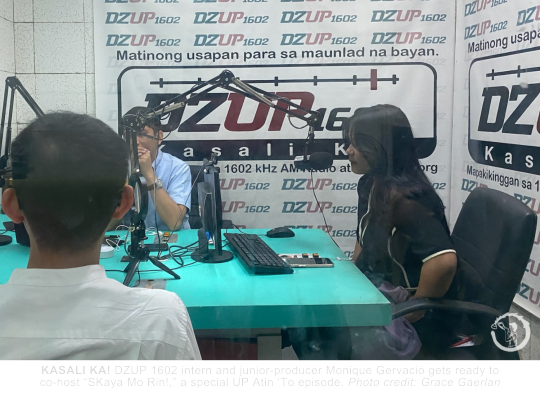
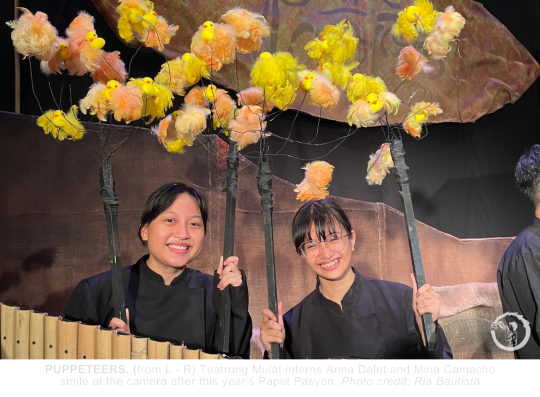
Business and Entrepreneurship (BE) Track
Grade 12 - Kapayapaan, the Business and Entrepreneurship (BE) track, experienced working at Underdog Fitness PH, Revised Salon, Friuli Trattoria, Puff & Dough BakeLab, SGD Coffee, Street Kohi, Noki Japanese Fried Chicken, and Urban Chick for their off-campus internship.
Some of their work included taking orders from customers, cleaning and setting up the area, making orders and food products for the business, assisting in supply inventory, creating and designing social media posts, preparing financial reports, assisting in administrative-related tasks, and conducting market research.
Princess Tan, a former intern at Noki Japanese Fried Chicken, shared her thoughts on how different the off-campus internship is from completing regular coursework for classes. “The real world is less structured than the system in school. The tasks we had to do weren’t listed for us and weren’t taught to us from the very start to end. You are expected to learn the operations as you go through the work program. Additionally, mistakes would cost you more unlike in school where you’ll just get a deduction on your score,“ she said.
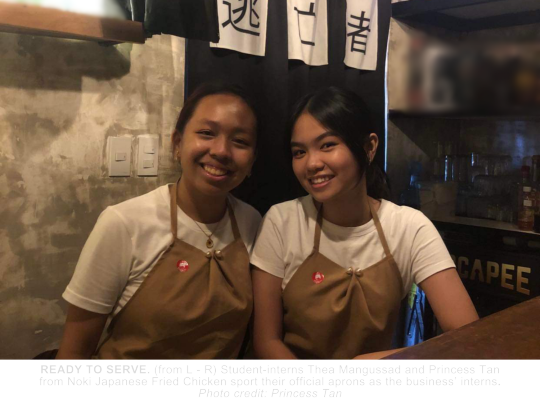
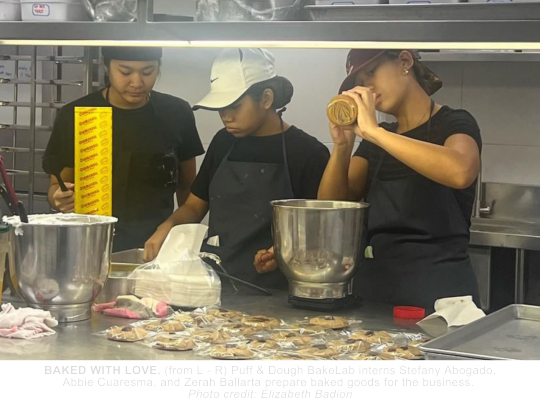

Applied Sciences and Engineering (ASE) Track
Grade 12 - Karangalan and Karunungan, the Applied Sciences and Engineering (ASE) track, held their internship programs at Ateneo de Manila University (ADMU) - Department of Information Systems and Computer Science (DISCS), ADMU - Department of Electronics, Computer, and Communications Engineering (ECCE), ADMU - Department of Mathematics, Buri Technologies, Department of Environment and Natural Resources (DENR) - Environmental Management Bureau (EMB), DENR - Mines and Geosciences Bureau (MGB), Department of Information and Communications Technology (DICT), Department of Science and Technology (DOST) - Advanced Science and Technology Institute (ASTI), DOST - Philippine Atmospheric, Geophysical, and Astronomical Services Administration (PAGASA), LCI Envi Corporation, New Era General Hospital, Smile Studio Dental, and Wilson Hobby Studio.
Some specific tasks given by the sites consisted of conducting playtests, exploring and programming with Artificial Intelligence (AI), attending workshops and seminars, testing websites, creating courses on websites, performing Test Case Documentation, listing products and packaging of companies, managing and operating with information and cybersecurity, weather research and reporting, assisting in dental-related work, input and documentation of dental procedures and prices, assisting in tech support with 2D software, 3D printing, and attending discussions and seminars held by the sites.
Enjoce Lampa, a former intern at ADMU - Department of Information Systems and Computer Science (DISCS), shared the skills he was able to develop or enhance through his experience. “The skill I used the most during the internship was definitely my knowledge in programming. I think I already had pretty good programming [or] coding knowledge from my experiences but this internship further enhanced my skills because I was able to use it on a real project. I learned the Godot game engine and its native language, GDScript, to create our game and I think I will be using this knowledge more in the future,“ he stated.
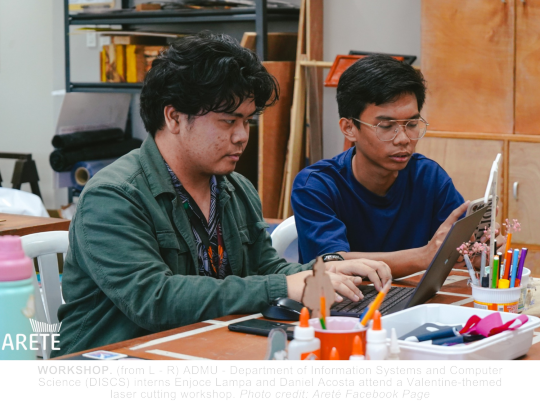
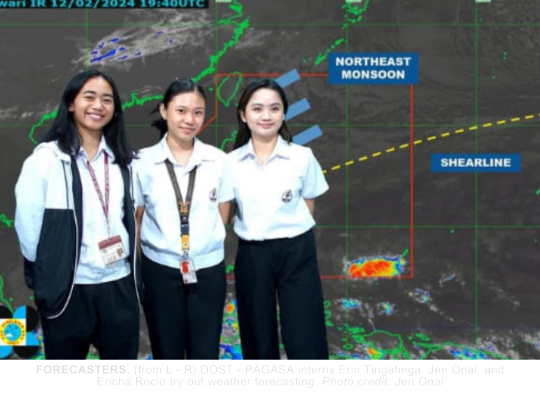
Batch 2024 is the first batch of Grade 12 students to experience separate cycles for their off-campus and on-campus internship since the pandemic. Last year, they finished their on-campus internship, which lasted from December 4 to 15. //by Mira Leaño and Ria Bautista
4 notes
·
View notes
Text

AlterMidya on Twitter @altermidya:
PHOTOS: Indigenous peoples and environmental groups protest at the Department of Environment and Natural Resources (DENR) earlier today, March 14, in time for the International Day of Action for Rivers and Against Large Dams. The groups asserted that the construction of mega dams worsens the current state of the environment, human rights, livelihood, cultures, and food security of the Indigenous Peoples.
“The mega-dams threaten the delicate balance of the ecosystems and the very survival of communities dependent on these rivers for their livelihoods,” states Beverly Longid, national convenor of Katribu Kalipunan ng Katutubong Mamamayan ng Pilipinas.
According to the Department of Energy, there are over 400 awarded hydropower power projects that are mostly dams.
Photos by Chantal Eco
2024 Mar. 14
4 notes
·
View notes
Text
0 notes
Link
3 min readPreparations for Next Moonwalk Simulations Underway (and Underwater) NASA’s DC-8 aircraft takes off from NASA’s Armstrong Flight Research Center Building 703 in Palmdale, California, to conduct test flights as part of the Airborne and Satellite Investigation of Asian Air Quality, or ASIA-AQ mission, that will collect detailed air quality data over several locations in Asia.NASA/Carla Thomas NASA and international researchers are studying the air quality in Asia as part of a global effort to better understand the air we breathe. In collaboration with Korea’s National Institute of Environmental Research (NIER), the Airborne and Satellite Investigation of Asian Air Quality, or ASIA-AQ mission, will collect detailed atmospheric data over several locations in Asia. Utilizing aircraft, satellites, and ground-based instruments, the ASIA-AQ team will gather and share data with air quality and government agencies to be used for air quality research and understanding worldwide. “Our purpose is to improve the understanding of the factors that control air quality,” said Jim Crawford, principal investigator for the ASIA-AQ mission at NASA’s Langley Research Center in Hampton, Virginia. “Multi-perspective observations are needed because satellites, ground-sites, and aircraft each see different aspects of air quality that need to be connected.” While satellite views and ground measurements provide significant data, alone they cannot completely illustrate air quality problems and the sources that cause them. By adding airborne measurements to models along with satellite and ground-based observations, scientists can achieve a multi-dimensional, detailed perspective that evaluates our air quality models from all angles. A pair of NASA science aircraft will help provide those additional dimensions to air quality observations. The DC-8 from NASA’s Armstrong Flight Research Center in Edwards, California, is outfitted with 26 instruments and will fly at low-altitudes to collect data from the atmosphere closest to the ground where people and habitats are impacted. Meanwhile, the G-III from NASA’s Langley Research Center in Hampton, Virginia, will fly at 28,000 feet altitude to create a high-resolution map of the pollution distribution in each study area, and how it changes throughout the day. Together with Korean aircraft from NIER, the NASA planes and instruments will supplement and cross-reference the observations made from the ground and satellite instruments. “Science missions for air quality [like ASIA-AQ] take a holistic approach of multiple perspectives to better understand our pollution issues,” said Laura Judd, platform scientist for NASA’s G-III aircraft. “If we can better understand how models simulate our air pollution, then we can forecast when these events unfold, and be able to disseminate that information to the public to make informed decisions.” Pollution changes as populations shift, economies ebb and flow, and industries move or evolve. The ASIA-AQ project will improve our ability to measure those changes and how they connect to the global scale. Bringing scientists, aircraft, and instruments together from across Asia and around the world, ASIA-AQ demonstrates how scientific advancement is a collaborative effort. “Scientists and agencies in each of the participating countries will ensure that ASIA-AQ targets the most important open air quality questions in their specific region,” said Barry Lefer, NASA program scientist for air quality research at NASA Headquarters. “And they’ll be the ones to implement improvements in their forecast models and advocate for policy changes.” ASIA-AQ is a joint effort between NASA and Korea’s National Institute of Environmental Research (NIER) and several international organizations including the Department of Environment and Natural Resources Philippines (DENR), the Universiti Kebangsaan Malaysia (UKM), the Geo-Informatics and Space Technology Development Agency Thailand (GISTDA) and the Ministry of Environment Taiwan (MOENV). Share Details Last Updated Feb 12, 2024 EditorDede DiniusContactElena [email protected] Flight Research Center Related TermsArmstrong Flight Research CenterAirborne ScienceDC-8Earth ScienceGeneralLangley Research CenterScience in the Air Explore More 5 min read Meet NASA’s Twin Spacecraft Headed to the Ends of the Earth Article 4 hours ago 2 min read Do NASA Science LIVE on February 21! What’s it mean to be cool? Snow and ice are everywhere this time of year—mountain tops, Alaska, and even outer space.… Article 5 hours ago 3 min read Third NASA Enabled Private Flight to Space Station Completes Safely Article 3 days ago Facebook logo @NASA@NASAArmstrong @NASA@NASAArmstrong Instagram logo @NASA@NASAArmstrong Keep Exploring Discover More Topics From NASA Armstrong Flight Research Center Langley Research Center Armstrong Science Projects Science in the Air
0 notes